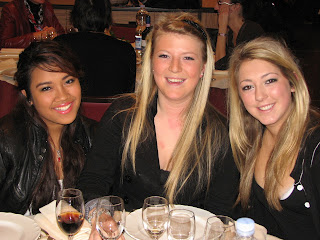A 5:30 a.m. departure for any reason is always difficult and even more so for a group of high school students. Nevertheless, we set off for Firenze (Florence) looking forward to exploring this wonderful city. The weather did not cooperate with our trip resulting in two days of rain unfortunately.
After arriving and checking into our hotels, we set off along the Arno River, which was a significant factor in Florence’s economic development from the 1200’s to 1400’s. We arrived thereafter at the Galleria dell’Academia to see Michelangelo’s statue, David. Michelangelo worked on this 5 m statue exclusively between 1501 and 1504. After its completion, it was agreed that it would not be placed at the top of the cathedral. Rather, it was placed in front of seat of government of the day. Michelangelo had captured the Florentine spirit of the day. His David is an idealized man of absolute aesthetic manhood who symbolized a city that began to see itself as made powerful by superior intelligence and culture not by brute strength. David was a defender of civil liberties, hence its placement outside the Palazzo Vecchio.
That evening we had the first of two dinners together at the hotel.
Rain plagued everyone the next morning as we set off for the museum and gallery tours that included Our students were able to choose between guided tours of the Science Museum to see works of Galileo and da Vinci; La Specola at the University of Florence which holds a comprehensive exhibit of insects, birds, animals and a unique collection of life size wax models of the internal organs of the human body; the Medici Tour which focussed on the life and times of one of the most famous and powerful Florentine Renaissance families; the Basilica di Santa Croce (Basilica of the Holy Cross) which is the church that is the resting place for , Michelangelo, Galileo, Machiavelli, Fosoloco, Gentile, Rossini, and Marconi, and the Bargello Gallery, which houses some if the Renaissance’s finest art collections.
Following lunch, the new students had tours of The Uffizi Gallery. This building was built between 1559 and 1574 by the Medici family to house the offices (uffizi means offices) of the four major guilds of the day so that they could monitor their business dealings. In 1737, Anna Maria Lusa, the last of her dynasty bequeathed the family’s art collection to the people of Florence; hence the gallery.
The Arno River and the Ponte Vecchio Bridge are seen here from the Uffizi Gallery.
The Ponte Vecchio Bridge spans the Arno at its narrowest point. The shops on the bridge once housed butchers (who would throw unwanted remains into the river), linen merchants, grocers and black smiths. These shops were later replaced by gold and jewellery shops as the river smelled so badly. The Gallery was designed by Vasari as what is known as Vasari’s Corridor. The corridor was built over the Ponte Vecchio in 1565 to allow the Duke and his family to go between their home in the Palazzo Pitti on one side of the Arno across to the their offices on the other side without having to mingle with the common folk below.
After the tours, some students remained in the gallery, some went off on their own and some accompanied some of the teachers who climbed the Duomo to see Firenze from above.
Dinner time!
 |
On Saturday, we set off for San Gimignano and Siena. San Gimignano is a beautiful hilltop fortified town in the heart of Tuscany. It is an ancient Etruscan town that grew in prominence and wealth over time. Leading families built towers such that at one point there were some 72 of them. Today, only 15 remain intact in this charming town.
About an hour away is Siena which was in the Middle Ages, in constant conflict with Florence until it was defeated by the Florentines in the 15th C.
The Duomo, built between 1136 and 1382 is a magnificent marble structure destined to be the largest cathedral in Europe. However, the arrival of the plague decimated the town and the expansion project was abandoned.
The beautiful piazza in the centre of town is the Piazza del Campo. It is a shell shaped piazza bordered by 12th C buildings. The fountain, the Fonte Gaia, located there is fed by a 500 year old aqueduct and is a replica of the original carved in the 14th C.
If you saw the last James Bond film, Quantum of Solace, you may recall the frenzied horse race at the beginning of the film. Twice a year, the piazza is used as a race track for the Palio. This is a bareback horse race which has its roots in the 13th C. Victory assures the jockey tremendous admiration from his citizens especially those in the contrada he represents.
Towering above the piazza is the Torre del Mangia, the second tallest bell tower in Italy. A 505 step climb up a very narrow staircase which a few of us managed, guarantees magnificent views of Siena and the local countryside.
Finally, at the end of a long day, it was time to return to Lanciano.







































No comments:
Post a Comment